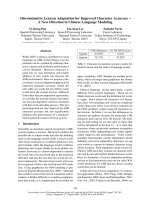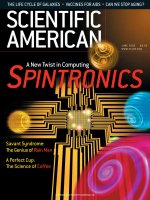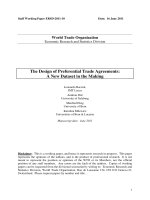- Trang chủ >>
- Mầm non - Tiểu học >>
- Lớp 5
5 4 2 a new girl in class
Bạn đang xem bản rút gọn của tài liệu. Xem và tải ngay bản đầy đủ của tài liệu tại đây (3.84 MB, 14 trang )
Suggested levels for Guided Reading, DRA,™
Lexile,® and Reading Recovery™ are provided
in the Pearson Scott Foresman Leveling Guide.
A New Girl
in Class
by Jason Lublinski
illustrated by Ron Mahoney
Genre
Realistic
fiction
Comprehension
Skills and Strategy
• Generalize
• Plot
• Predict
Scott Foresman Reading Street 5.4.2
ISBN 0-328-13550-X
ì<(sk$m)=bdf aj< +^-Ä-U-Ä-U
Reader Response
A New Girl
in Class
1. What do you think most muscular disorders have in
common? Use a chart like the one below to record
some details and the generalizations you can make
from them.
Detail
Detail
Detail
Generalization
Generalization
2. Did you predict the surprise Karen had at the end of
the story? What clue came earlier in the story? Make
a prediction about what will happen after the story is
over.
by Jason Lublinski
by Ron “When
Mahoney
3. On page 11,illustrated
there is a sentence:
I started
to sit up and crawl—all Lisa could do was lie there
on her abdomen.” Look up the word abdomen in a
dictionary. Write down its meaning and then write a
sentence using a synonym for the word abdomen.
4. Karen explains that Lisa was born prematurely. How
do you think this might have led to Lisa getting
cerebral palsy?
Editorial Offices: Glenview, Illinois • Parsippany, New Jersey • New York, New York
Sales Offices: Needham, Massachusetts • Duluth, Georgia • Glenview, Illinois
Coppell, Texas • Ontario, California • Mesa, Arizona
Mr. Porter’s fifth grade class learned that a new
student would be joining them in a few weeks. Mr.
Porter told them a little bit about her. Her name was
Lisa, and she had cerebral palsy.
“Does anyone know what cerebral palsy is?” Mr.
Porter asked.
Karen raised her hand. “I know that kids who
have it are handicapped,” she said.
“That’s right, Karen,” Mr. Porter said. “Does
anyone know anything more about it?”
Every effort has been made to secure permission and provide appropriate credit for
photographic material. The publisher deeply regrets any omission and pledges to
correct errors called to its attention in subsequent editions.
Unless otherwise acknowledged, all photographs are the property of Scott Foresman,
a division of Pearson Education.
24 ©Tom Nebbia/CORBIS
ISBN: 0-328-13550-X
Copyright © Pearson Education, Inc.
All Rights Reserved. Printed in the United States of America. This publication is
protected by Copyright, and permission should be obtained from the publisher
prior to any prohibited reproduction, storage in a retrieval system, or transmission
in any form by any means, electronic, mechanical, photocopying, recording, or
likewise. For information regarding permission(s), write to: Permissions Department,
Scott Foresman, 1900 East Lake Avenue, Glenview, Illinois 60025.
2 3 4 5 6 7 8 9 10 V0G1 14 13 12 11 10 09 08 07 06 05
3
When no one said anything, Mr. Porter continued.
“It’s a condition that a person is sometimes born
with. It prevents the person from developing motor
skills properly.”
“What are motor skills?” asked Dave, thinking of
his new remote control car.
“Motor skills are basically movement skills, Dave,”
Mr. Porter said. “Babies born with cerebral palsy
often have a hard time learning to roll over, sit up,
stand, or walk. They can develop these skills, but
it takes them much longer than usual—sometimes
many years.”
4
Maria asked, “How do they learn these skills?”
“They usually need a lot of physical therapy
to learn to control and develop their muscles.
Sometimes kids with cerebral palsy are helped by
wearing braces. They—and their parents—have to
work hard and have a lot of patience,” Mr. Porter
explained.
“I guess if you have cerebral palsy, you can’t play
in regular sports and stuff,” said Franco. He was
thinking about how he loved playing soccer.
“Right,” Mr. Porter answered, “but the condition
can improve with time.”
5
“Why do only some kids get cerebral palsy?”
asked Franco.
“Scientists are not entirely sure,” Mr. Porter
paused. “In general, some scientists believe it’s the
result of not enough oxygen getting to the brain in
the early stages of development.”
Tony asked, “You mean like before a baby is
born?”
6
“That’s right, Tony,” Mr. Porter said. “Before,
during, and just after their birth are very critical
times for a baby.”
Bobby was waving his hand wildly. When Mr.
Porter called on him, he asked, “What’s so important
about oxygen? Look! I can go without it!” He stood
up, puffed out his cheeks, and held his breath.
Everyone in the class started laughing and some
of them started counting to see how long he could
hold it. After a minute, Bobby was starting to turn
red. Suddenly he let go of his breath and sat down in
his seat, completely tired out.
“Thanks for that demonstration, Bobby,” Mr.
Porter said. “I think you’ve helped us see exactly why
oxygen is so important. We really can’t go without it
for more than a minute or two.”
7
He continued, “Thanks to Bobby, we’ve seen what
happens when you don’t get enough oxygen. Now,
who can tell me what happens when you breathe in
oxygen?”
Karen said, “It goes into your lungs.”
“That’s right,” Mr. Porter nodded. “Then what
happens?”
Karen thought for a moment. “Doesn’t it get
absorbed into your bloodstream?” she asked.
“Right again, Karen,” Mr. Porter said. “And
then?”
8
Karen said, “Your blood carries the oxygen to all
different parts of your body—including your brain.
So babies who don’t get enough oxygen can get
cerebral palsy. Their brains don’t get enough oxygen
to help them develop properly.”
“That’s exactly right, Karen. That’s what
happened to Lisa, the girl who is going to join our
class in a few weeks,” said Mr. Porter.
Everyone looked shocked when they heard this.
They all were silent for a moment. Then, suddenly,
everyone started asking questions all at once.
“Can Lisa talk?”
“Can she walk?”
“Is she in a wheelchair?”
“Where will she sit?”
“Where has she been going to school?”
9
Mr. Porter raised his hands to quiet everyone
down. “I’ll try to answer all your questions. Last one
first. She’s been going to a special school up until
now. Her therapist and teachers feel that she is ready
to join us in a regular classroom.
10
Lisa has worked very long and hard. She talks with
a little difficulty, we can get used to that. She wears
braces on her legs, and her gait is a little uneven, but
she can get around on her own. She may not be able
to play basketball, but I hear she’s a whiz at math.”
Karen had her hand in the air. She was sitting
very patiently and quietly, and it was clear she had
something very important to say.
Mr. Porter called on her.
“Mr. Porter, I think I know Lisa. Her mother is a
friend of my mom’s. In fact, Lisa and I were born in
the same hospital. That’s how our moms met. Lisa
was a few months premature. When I started to sit
up and crawl—all Lisa could do was lie there on her
abdomen.”
Karen was silent for a moment. “Lisa is a really
brave girl. She’s worked hard to get where she is
today.”
Now the whole class was silent. Then Dave asked,
“Mr. Porter, isn’t there something we could do to
help kids like Lisa?”
11
The class offered lots of ideas for the next hour,
and Mr. Porter listed them on the board. In the end,
they decided they wanted to raise some money
for research on cerebral palsy and other muscular
disorders affecting kids. But how? They went back to
brainstorming.
“We could sell candy,” Franco said.
“No, you know the soccer team is already doing
that,” said Maria. “They’re raising money for a new
field,” she explained.
“Why don’t we put on a show?” Tony suggested.
“We’d charge for the tickets.”
12
“No,” said Maria. “It would take too much time.
We would need a lot of help to put something like
that together.”
“How about a walk-a-thon?” asked Karen.
“That sounds great,” said Dave. “What do we
have to do?”
“Well,” Karen replied, “we can ask people to
volunteer to walk a few miles. We’ll come up with
a day and a route to walk. Before the walk, each
walker will sign up sponsors. Each sponsor will pay a
few dollars for every mile that the person walks.”
“That’s a great idea!” said Tony. “My mom runs in
a race like that every year to raise money.”
“Mr. Porter, tell us what we need to do to set up
this walk-a-thon,” Dave said.
13
“I guess the first thing we need to do,” said
Karen, “is get permission from the school.”
“That’s right,” agreed Mr. Porter. “Who would
like to go to Mr. Forgle and ask him for permission?”
Karen and Dave raised their hands.
That day, after school, Karen and Dave walked
over to Mr. Forgle’s office. Mr. Forgle was their
school principal.
Karen knocked on the door. Then, a loud voice
told them to enter.
Mr. Forgle was a big, bald man who liked to wear
plaid suits.
14
“Karen!” he said, smiling. “Dave! What brings the
two of you here? Not in any trouble, I hope!”
“Not at all,” Karen said. “You see, Mr. Forgle,
Dave and I wanted to ask you for permission.”
“Permission for what?” asked Mr. Forgle.
“Permission to hold a walk-a-thon!” said Dave.
“You see, our class would like to raise money for
research to help kids who have muscular disorders,
Mr. Forgle. We want to hold it here at the school
track.”
“Well,” said Mr. Forgle, “I think it sounds like a
great idea! I love to see students helping a good
cause. You have my full support.”
15
While they were walking home together, Dave
and Karen talked about their plans.
“He said we could do it,” said Dave, “just like
that!”
“I know, Dave,” Karen agreed. “Now comes the
tough part. Getting walkers for a walk-a-thon will
take a lot of hard work. We will have to talk to every
student in the school. We want as many walkers as
possible.”
16
“We also need to ask each walker to get as many
sponsors as possible,” Dave reminded her. “We can
only raise a lot of money if we have a lot of walkers
and a lot of sponsors.”
At school the next day, Dave and Karen told the
class about their talk with Mr. Forgle. They also
explained the hard work that lay ahead.
“This won’t be easy, but it will be worth it, believe
me,” Karen told the class.
“Look,” said Bobby. “I want to raise money for
muscular disorders just as much as you do, but there
are hundreds of students in our school. Yikes!”
“It has to be done,” said Maria. “We’re the ones
who have to do it.”
Karen and Dave suggested that the class divide
into teams—one team for each grade in the school.
Then each team would meet with students to recruit
walkers for the walk-a-thon.
17
For the next week, the teams met every day and
reported their progress to the class.
“I had great luck with the sixth graders,” Karen
reported. “A lot of them agreed to be walkers. One
girl, named Sue, said that her mom is a medical
researcher.”
“A medical researcher?” asked Tony.
“That’s right,” said Karen. “She looks to find ways
to cure diseases. She knows all about cerebral palsy.
And Sue’s brother is a physical therapist. He helps
people walk and move around better. He works
with many people who have cerebral palsy or other
muscular disorders and who must walk with artificial
supports.”
18
“Okay, teams. How many walkers did you get?”
Karen asked.
Dave wrote the grade and the number of walkers
on the board. In all, about 20 kids had volunteered
to walk.
“That’s great!” said Karen.
“How many miles are the walkers supposed to
walk?” asked Dave.
“We’re going to walk about five miles,” said
Karen.
Karen and Dave then handed out forms for
walkers to use to sign up their sponsors. That way,
the kids could keep track of the money they raised.
On the big day, Karen and Dave were pleased to
see that all of the walkers who signed up arrived at
the school track to take part in the walk-a-thon.
19
Mr. Porter came up to Dave and Karen just before
the event started. “Congratulations!” he said. “We
have a great turnout.”
“Thanks, Mr. Porter,” said Dave, with a big grin.
“Really,” continued the science teacher, “I’m
impressed with the way you helped the class put
together such a wonderful fundraiser.”
“It’s all because of you, Mr. Porter!” said Karen.
“You did such a good job of teaching us about
cerebral palsy that we had to do something to help.”
20
21
“I know we’re going to raise a lot of money!” said
Dave.
As walkers lined up to begin, Mr. Forgle gave a
speech.
“I want to thank you all for coming today. This is
a great cause. It’s wonderful to see so many caring
people,” he said.
“I also want to thank Karen Barrington and Dave
Peterson for making this happen. We appreciate all
your hard work.”
The crowd started cheering and clapping for
Karen and Dave.
22
Karen stepped up to the microphone. She had
something special to say. “I want to thank you all
for coming out today, especially our walkers. In fact,
I’d like to introduce one special walker to you. This
is Lisa. She is new to our school. Lisa, everyone at
Orville Elementary wants to say ‘welcome.’”
Lisa stepped out in front of the crowd. She stood
there proudly for a moment beside Karen and Dave.
Then she went to take her place in the walk-a-thon
line-up.
The walk-a-thon was a huge success. It earned
even more money than Karen and Dave had
expected. And everyone got to know Lisa. In fact,
they had so much fun that they decided to hold a
walk-a-thon again the following year.
23
Cerebral Palsy
Reader Response
Cerebral palsy is a neuromuscular disorder that
affects babies and children. Some cases may be a
result of a lack of oxygen to the brain during the
early stages of development—before, during, and
immediately after birth.
Cerebral palsy usually does not worsen. In fact,
children with this condition often improve over time.
They can be helped by physical therapy. Children
with cerebral palsy must work hard to develop and
regain control of their muscles. Sometimes they use
artificial supports, such as braces. Some may even
need to use wheelchairs.
Cerebral palsy can be prevented. Scientists are
working to better understand its causes and to
develop ways of helping children with this condition.
1. What do you think most muscular disorders have in
common? Use a chart like the one below to record
some details and the generalizations you can make
from them.
Detail
Detail
Detail
Generalization
Generalization
2. Did you predict the surprise Karen had at the end of
the story? What clue came earlier in the story? Make
a prediction about what will happen after the story is
over.
3. On page 11, there is a sentence: “When I started
to sit up and crawl—all Lisa could do was lie there
on her abdomen.” Look up the word abdomen in a
dictionary. Write down its meaning and then write a
sentence using a synonym for the word abdomen.
4. Karen explains that Lisa was born prematurely. How
do you think this might have led to Lisa getting
cerebral palsy?
24









